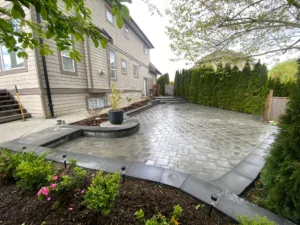Allan Block Retaining Wall
Allan Block retaining walls give your yard a bold new look. They can do a lot and they looks good. Allan Block's aesthetics and versatility make it the right choice for those who appreciate the right mix of form and function. Allan Block has been expanding their catalogue, offering new colours, blends, shapes, sizes and more.










Allan Block Style Options
There is a wide range of available colours and blends of colour styles as well as different patterns styles of Allan Block. (check the Allan Blocks Website for the complete catalogue). Here are a few installations we have done that show a few Allan Block options.
Classic Grey
The original Allan Block. Simple but sharp. The wall shown here is the classic grey with charcoal caps.


Silverado Blend
Allan Block also has blended colours. This retaining wall was built using the Silverado blend Allan Blocks. Blended blocks give a more unique look to the wall. Silverado is a blend between the classic grey and charcoal colours.
Metropolitan Finish (Grey)
Allan Block has been diversifying from the traditional look by also offering more modern smooth face stones. This Allan Block stairway uses the Metropolitan Finish block system.

How We Price Allan Block Builds
Typically Allan Block walls have costed around $40 – $100 per square foot of wall. Although that price range has seen some increases in the past few years due to several factors, what hasn't changed is the powerful appearance and built to last promise these walls embody! So while an Allan Block wall isn't cheap, it is an excellent investment in any property.
Square foot of wall is measured as length x height. For example, if the wall is 2 feet tall and 40 feet long there would be 80 square feet (2’x40’). An Allan Block wall this size would cost between $4,000 - $8,000. As you can see the cost can be quite variable. There are a few reasons for that variability in cost but as a general rule it just comes down to the time it takes to build (for the most part). Some of the specific factors that determine the cost are as follow:
Grade Changes (Slope) – If the wall is running along a sloped area, the wall may need “step ups” to follow the height change. These “Step ups” add to both labour and materials.
Amount of Backfilling Required – If you are raising up the ground to create a terrace area, this will impact the cost.
Base Course – The Base Course (bottom row) of the wall is the timeliest to install as it needs to be perfectly level to build on. If the base course is long in comparison to the height of the wall, this can increase the price/sqft of wall.
Pre Existing Condition – A lot of preparation work goes into creating the area where the wall will be constructed. Cost many reflect the amount of excavation and disposal needed and in many cases the demolition and removal of the previous wall that is being replaced. Removal and disposal of existing material can be a cost driver.
Access – Retaining walls require a 4-6-inch base of crushed gravel plus the wall blocks. Poor access will increase the labour time moving the materials in for the project.






